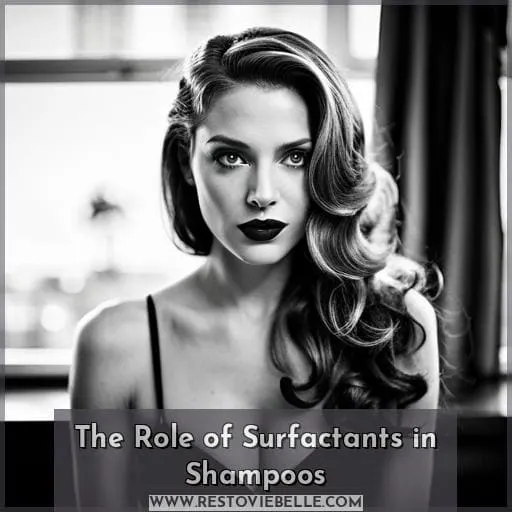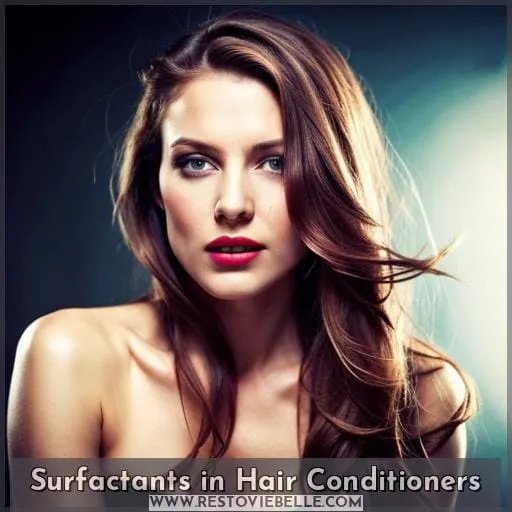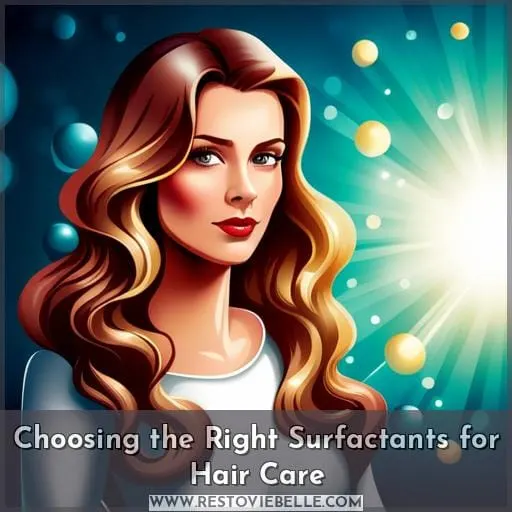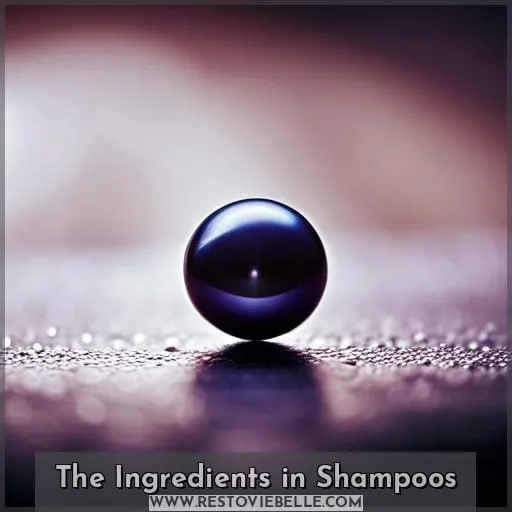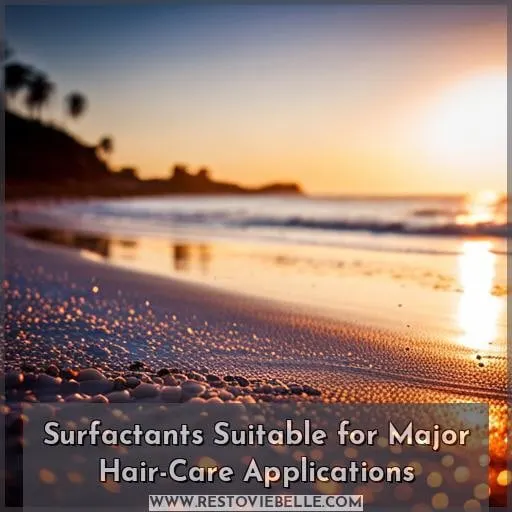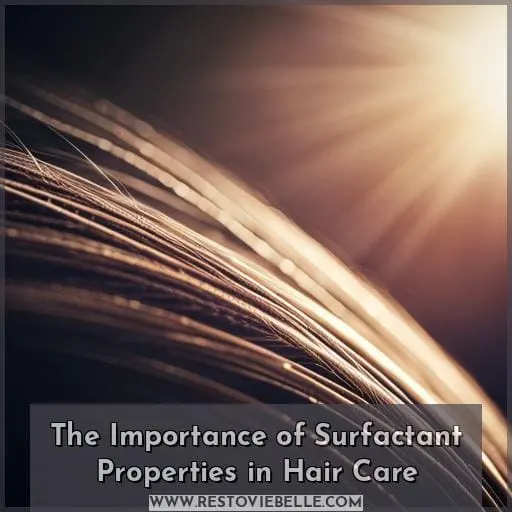This site is supported by our readers. We may earn a commission, at no cost to you, if you purchase through links.
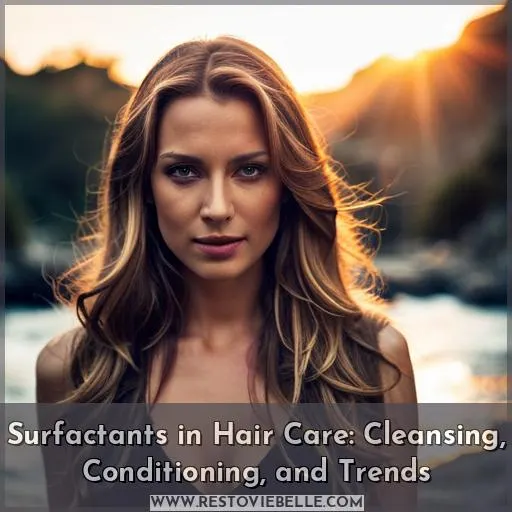 Are you looking to upgrade your hair care routine? Surfactants are an essential part of most products, and understanding their role is key for achieving healthy, beautiful locks. From cleansing to conditioning, surfactants in hair care play a vital role in gaining the desired results.
Are you looking to upgrade your hair care routine? Surfactants are an essential part of most products, and understanding their role is key for achieving healthy, beautiful locks. From cleansing to conditioning, surfactants in hair care play a vital role in gaining the desired results.
In this article, we’ll explore how they work and what trends have emerged over recent years when it comes to choosing which ones are best for your needs.
Table Of Contents
- Key Takeaways
- What Are Surfactants in Hair Care?
- The Role of Surfactants in Shampoos
- Trends in Shampoos and Surfactants
- Surfactants in Hair Conditioners
- Analyzing Detergent Formulations
- Choosing the Right Surfactants for Hair Care
- The Ingredients in Shampoos
- Personalized Hair Consultation for Surfactant Selection
- Surfactants Suitable for Major Hair-Care Applications
- The Importance of Surfactant Properties in Hair Care
- Conclusion
Key Takeaways
- Surfactants play a crucial role in both cleansing and conditioning in hair care.
- There are three main types of surfactants: anionic, amphoteric, and cationic.
- Surfactants are key ingredients in shampoos and conditioners, with anionic surfactants commonly found in shampoos.
- Trends in hair care favor sulfate-free and eco-friendly options, with a focus on natural and milder surfactants.
What Are Surfactants in Hair Care?
Surfactants are compounds used in hair care products to provide cleansing and conditioning. They can be divided into three main groups – anionic (strong), amphoteric (mild), and cationic (conditioning).
Anionic surfactants help remove dirt, oil, and residues, while conditioning surfactants add volume to hair by providing hydration and smoothing the cuticle.
Cleansing Surfactants
Cleansing surfactants are compounds used to remove dirt, oil, and residues from your hair. For example, the acacia collagen in a natural shampoo protected one customer’s locks. These surfactants work by combining with water to create foaming agents. This foaming action helps maintain scalp health and cleanses more effectively than other ingredients.
When choosing a suitable cleanser, it is important to consider the foaming properties and conditioning benefits, as well as the basic cleansing efficiency. Some surfactants have strong foam properties, while others may be milder but still highly effective at cleansing without damaging delicate strands or altering hair texture.
Conditioning Surfactants
Conditioning surfactants provide your hair with lasting hydration and smoothness. Cationic surfactants are the most commonly used for conditioning effects, as they attach to the hair shaft and add a layer of protection that helps to lock in moisture.
Non-ionic surfactants help soften and protect cuticles while improving manageability. When selecting a conditioner, it’s important to choose one with appropriate ingredients for your specific needs. Some may be too harsh or drying, while others may not provide enough hydration benefits or conditioning effects needed for certain types of hair textures.
With careful selection, you can achieve healthy-looking locks by using products tailored specifically towards achieving desired results like smoothness and shine!
Types of Surfactants
When it comes to hair care, there are three main types of surfactants: anionic (strong), amphoteric (mild), and cationic (conditioning). Anionic surfactants have a negative charge that provides more volume while removing dirt, oil, and residues.
Amphoteric formulations are milder alternatives for sensitive skin with conditioning benefits. Cationic polymers provide extra hydration by smoothing the hair cuticle with their positive charge.
Surfactant trends focus on sulfate-free solutions due to their gentleness and eco-friendly options using natural compounds like acacia collagen.
The Role of Surfactants in Shampoos
It’s essential for healthy hair to understand the role of surfactants in shampoos. Shampoo is mainly used to cleanse the scalp and hair, typically containing 10-20% surfactants such as sodium laureth sulfate, which act as primary cleansing agents.
Additionally, cocamidopropyl betaine and cocamide MEA are used for lathering, while zinc pyrithione or antifungal actives combat dandruff. Conditioners like silicones or conditioning oils can also be added depending on one’s individual needs.
Cleansing the Scalp and Hair
By choosing the right surfactants for your hair, you can get a deep cleanse that leaves your scalp feeling refreshed. Anionic surfactants like sodium laureth sulfate are primary cleansing agents, and cocamidopropyl betaine and cocamide MEA aid in lathering.
Zinc pyrithione helps combat dandruff, while conditioning shampoos deposit moisturizing actives to provide softness and shine. Sulfate-free formulas are milder on the scalp but still effective at removing dirt, oil, and residues from hair strands without stripping away too much moisture or natural oils.
Primary Cleansing Agents
Anionic surfactants like sodium laureth sulfate are the primary cleansing agents in shampoos. They create a lather that helps cleanse dirt, oil, and other residues from the scalp and hair. Their negative charge boosts volume while their detergent formulations ensure compatibility with various ingredients for efficient cleaning.
These surfactants also provide different levels of effectiveness depending on one’s hair type. They can be too harsh or mild for some scalps but optimal for others when it comes to achieving healthy hair results.
In addition, they have good lathering efficiency, which makes them ideal primary cleansing agents in shampoo formulations today.
Additional Shampoo Ingredients
Besides cleansing agents, shampoos also contain ingredients like cocamidopropyl betaine and cocamide MEA to create a luxurious lather. Zinc pyrithione and antifungal actives combat dandruff, while conditioning formulations deposit moisturizing agents onto the scalp to maintain healthy hair.
Paraben alternatives, such as acacia collagen, provide both protection and moisture without disrupting hormones. For maximum benefit, personalized consultations with hair care experts can help identify suitable shampoo ingredients for each individual’s needs.
Trends in Shampoos and Surfactants
You may have heard that sulfate and silicone-free shampoos, as well as those with amino acid-based surfactants, are becoming increasingly popular. These trends in shampoos can be attributed to the effectiveness of these ingredients, which provide mild yet effective cleansing without being overly harsh on hair.
Sulfate Vs. Sulfate-Free Shampoos
You can choose between sulfate-containing and sulfate-free shampoos, each with their own unique benefits. Sulfates are powerful surfactants that provide a deep clean but may be harsh or irritating to the scalp.
On the other hand, sulfate-free products use milder ingredients like amino acid-based surfactants for more gentle cleansing while still providing effective hair care results. The impact of these different formulations on hair health is something to consider when choosing a shampoo.
For those looking for extra safety precautions or eco-friendly options, it’s best to select a product free from synthetic compounds or parabens, which can disrupt hormones in some cases.
Silicone-Free Shampoos
Swap out that silicone-laden shampoo and give your hair a healthier alternative with these sulfate-free, silicone-free options. Silicone-free benefits include reduced polymer deposition on the hair shaft, enhanced hydrophobic moiety protection, and increased natural ingredients for better hair health.
Alternative formulations are eco-friendly options that contain natural surfactants such as amino acid derivatives, which provide mild cleansing without harshness or irritation.
Amino Acid-Based Surfactants
Amino acid-based surfactants are the latest trend in shampoos, so you can keep up with modern times and give your locks some love. These surfactants are derived from amino acids, which possess a unique hydrophobic tail that aids emulsification.
They also increase surface tension reduction for scalp health and provide mildness to hair care products.
They’re also eco-friendly options as they don’t contain any harsh sulfates or silicones, which could damage the skin barrier or cause irritation and dryness. Whether you choose anionic or cationic based amino acid formulations depends on personal preference.
Surfactants in Hair Conditioners
You may have heard of surfactants in shampoos, but did you know that they are also used in hair conditioners? Conditioning agents such as cationic surfactants provide hydration and smoothing properties to the hair cuticle, while conditioning actives like silicones and moisturizing oils repair damaged strands.
Hydration and Smoothing
Conditioning surfactants provide your hair with hydration and smoothing benefits, restoring a healthy shine. They work through their cationic properties, which help balance the moisture in hair. Anionic surfactants are used to cleanse, while amphoteric ones bring mildness for sensitive scalps.
Cationic surfactants have positive charges that attract water molecules and condition the cuticle for softness and smoothness. Hydration techniques like hyaluronic acid can also be included in these products to maximize benefits without overwhelming the scalp or strands of hair with too much product buildup.
Cationic Surfactants
Discover how cationic surfactants can help give your hair the hydration and smoothness you desire! Cationic surfactants are positively charged molecules that provide conditioning benefits to hair. Unlike anionic surfactants, like sodium lauryl ether sulfate, they don’t strip away natural oils.
Popular cationic ingredients include cocamidopropyl betaine and steartrimonium chloride. Quaternium-33 is a milder option for sensitive skin types. While some may worry about safety concerns with these compounds, studies have shown them to be non-toxic when used in recommended quantities in haircare products.
As a result of their superior hydrating properties compared to other options on the market, more brands are incorporating them into their formulations for maximum effectiveness without causing damage or irritation.
Conditioning Actives
Unveil the power of conditioning actives to amplify hydration and smoothness in hair care. Surfactants, when used as conditioning actives, provide hydration and improve hair porosity. They also protect scalp health by removing contaminants from the hair shafts, such as sebum build-up, which can block nutrient absorption.
Additionally, they are tailored to a variety of different hair types with varying cleansing methods that consider each individual’s unique needs for optimal results.
Analyzing Detergent Formulations
Analyzing detergent formulations is a crucial factor in comprehending the effectiveness of surfactants in hair care. Techniques like spectroscopy and chromatography can be employed to identify these surfactants and ascertain their efficacy.
Techniques for Surfactant Identification
Unlock the secrets of your hair care products with techniques like spectroscopy and chromatography, which can help identify surfactants for a customized routine.
Spectroscopy analysis is used to detect hydrocarbon chain lengths in cationic surfactants.
Chromatographic techniques are used to analyze surface adsorption properties of anionic and amphoteric compounds, while also allowing for identification methods such as gas chromatography-mass spectrometry (GCMS).
Analytical approaches using high performance liquid chromatography (HPLC) help confirm the presence of organic acids or amino acids commonly found in detergents.
With these analytical tools, you can gain insight into the components that make up your favorite shampoos and conditioners so that you can create a personalized haircare routine tailored specifically to you!
Spectroscopy and Chromatography
Compare your hair care formula with Spectroscopy and Chromatography to find the perfect balance of cleansing and conditioning surfactants! By using these analytical methods, you can determine its chemical composition.
Spectroscopy applications help in understanding the functional properties of individual components in a mixture, while Chromatography techniques allow you to identify all the present surfactants. Surfactant analysis reveals how they interact together when mixed into a formulation, enabling precise control over their performance.
Choosing the Right Surfactants for Hair Care
When it comes to selecting surfactants for hair care, the balance between mildness and oil removal must be considered. To achieve this balance, it is recommended to use natural and milder surfactants that are also eco-friendly and non-toxic.
Balancing Mildness and Oil Removal
Finding the right balance between mildness and oil removal is essential when choosing surfactants for hair care. Natural surfactants are preferred as they tend to be more gentle on both the scalp and hair, while still being effective in cleansing.
However, some natural options may not be suitable for oily scalps or certain types of hair textures since their efficacy can vary greatly from one product to another.
For this reason, personalized recommendations by a haircare consultant may help identify which surfactant will work best with your individual needs in terms of oil balancing and mildness. Additionally, eco-friendly choices should also be considered as these often contain fewer harsh chemicals than synthetic alternatives that can disrupt hormones over time.
Natural and Milder Surfactants
When considering your hair’s needs, milder and natural surfactants can be a great option to balance out cleansing and conditioning. Natural formulations like acacia collagen are safe to use as they protect the scalp from irritation while providing deep hydration.
Eco-friendly choices, such as plant-based derivatives, offer sustainable cleansing of dirt and oil without harsh detergents. Mild surfactants help maintain healthy pH levels in the scalp, contributing to healthier-looking hair for longer periods of time.
Hair-friendly options include fatty acid-based ingredients that provide gentle exfoliation while keeping locks soft and shiny with no residue buildup or damage over time.
Eco-Friendly and Non-Toxic Options
You can help your hair look and feel its best with eco-friendly, non-toxic surfactants. Natural ingredient choices like sugar esters or wheat proteins are sustainable alternatives to synthetic ingredients.
Cationic polymers provide long-lasting conditioning without harsh chemicals. Many green surfactant options offer milder cleansing and foaming action compared to sulfates, which may be too harsh on the scalp.
When choosing a shampoo formulation for your hair type, consider sustainability considerations that come with certain formulations. Some shampoos contain palm oil derivatives that have environmental impact concerns associated with them.
To ensure your choice is as safe for the environment as it is healthy for your hair, opt for an eco-friendly alternative such as vegetable-derived glycerin or coconut-based cleansers instead of petroleum derivatives like PEGs and ethoxylated compounds found in conventional products.
The Ingredients in Shampoos
When it comes to shampoo, there are several key ingredients that you should be aware of. Water is the base ingredient, while preservatives and moisturizing agents help keep the product fresh and nourish hair, respectively.
Synthetic shampoos often contain parabens, which can disrupt hormones in our bodies, so natural alternatives such as acacia collagen may be a better option for healthier hair.
Water, Preservatives, and Moisturizing Agents
In addition to surfactants, shampoos contain water, preservatives, and moisturizers so your ‘do stays fresh for the long haul. The water content impacts its effectiveness; too little or too much can reduce lather and efficacy.
Preservative levels must be balanced to ensure product safety without compromising effectiveness. Moisturizer compatibility is also important; it should not interfere with other active ingredients or reduce the shelf life of the shampoo formula.
For optimal ingredient stability and product shelf life, consider the pH level when selecting preservatives and moisturizing agents in hair care formulas containing surfactants.
Synthetic Shampoos and Parabens
Synthetic shampoos may contain parabens, which can throw your hormones out of whack. To protect hair health and prevent such hormonal disruption, look for eco-friendly alternatives with natural ingredients like acacia collagen.
Get personalized recommendations from a haircare consultant to ensure you find the perfect shampoo formula suited to your needs.
Consider avoiding sulfates as they’re harsh detergents that strip away essential oils and moisture from the scalp and hair shafts.
When choosing a shampoo, prioritize finding one that balances both mildness and oil removal while being non-toxic at the same time.
Natural Alternatives
Discover how natural alternatives like acacia collagen can protect and moisturize your hair. Plant-based surfactants are a great eco-friendly option for cleansing, while DIY solutions using ingredients such as olive oil or honey can be used to provide conditioning benefits.
Organic substitutes like aloe vera gel and coconut milk also offer gentle cleansing properties without harsh chemicals. For those seeking an all-natural solution, there are numerous plant-based options on the market that contain essential oils or other naturally derived ingredients.
These options help nourish the scalp while offering protection from environmental pollutants.
With so many organic substitutes available, it’s easy to find a product that suits your needs for healthy hair care!
Personalized Hair Consultation for Surfactant Selection
When it comes to selecting surfactants for hair care products, personalized advice can be invaluable. Hair care consultants are equipped with the knowledge necessary to identify suitable ingredients that promote healthy hair, making them an excellent resource in achieving this goal.
Benefits of Personalized Advice
Getting personalized advice from a hair care consultant can help you identify the right ingredients for healthy hair. Tailored solutions are available to suit different types of hair, with expert guidance on surfactants and benefit agents like foaming and conditioners.
Customized advice is beneficial in providing recommendations that best fit individual needs, such as sulfate-free or natural options.
Identifying Suitable Ingredients
Finding the right formula for your hair can be a daunting task, but personalized advice from a hair care consultant can help. They will consider ingredient compatibility, custom formulations based on your hair type, and eco-friendly options to achieve healthy locks.
Detergency, skin mildness, foam stability, and rheology control are some of the key factors in surfactant selection that need to be taken into account when creating effective shampoos or conditioners tailored specifically to you.
Haircare Consultants
A haircut can truly benefit from a personalized consultation, so let an experienced haircare consultant help you find the right ingredients for healthy hair. Consultants are up to date on all haircare trends and solutions, making them knowledgeable in ingredient selection.
From gentle sulfate-free amphoteric surfactants to hydrating butylene glycol and cocamidopropyl betaine, they will advise you on the best combinations tailored to your individual needs.
Surfactants Suitable for Major Hair-Care Applications
Surfactants are essential components in hair care products as they help to cleanse and condition the scalp and hair. Depending on the application, different types of surfactants can be used for shampoos or conditioners; anionic surfactants are commonly used in shampoos, while conditioning surfactants such as cationic ones work best with conditioners.
Surfactants for Shampoos
Unlock your hair’s potential by selecting the right surfactants for shampoo applications. Shampoos typically contain 10-20% of anionic surfactants such as sodium laureth sulfate to cleanse the scalp and hair, while cocamidopropyl betaine aids in lathering.
Zinc pyrithione and antifungal actives help combat dandruff, while conditioning agents like silicones or oils moisturize dry strands.
Surfactants for Conditioners
Conditioning your hair requires the right surfactants, just like choosing the perfect outfit for a special occasion – each ingredient playing a unique role. Cationic conditioners are commonly used to boost hydration benefits: Cocamidopropylbetaine, cetrimonium chloride, and stearalkonium chloride being popular choices.
The selection of these surfactants depends on the desired smoothing effects and styling products needed. Haircare consultations can help determine which ones are best suited for individual needs while providing liberation from damaging ingredients in traditional formulations.
The Importance of Surfactant Properties in Hair Care
You probably know that surfactants are key components of hair care products, but did you know they also have important properties? Cleansing, foaming, mildness, and phase behavior all play a role in ensuring the efficacy of these products.
Furthermore, their rheology control is essential in making sure they operate as intended. By understanding how these properties interact with each other and affect performance, we can ensure optimal results for our customers.
Cleansing Properties
You need to consider the cleansing properties of surfactants when selecting a hair care product for your needs. Clarifying shampoos use strong anionic surfactants, while milder amphoteric and cationic ones are better suited for regular maintenance.
Natural alternatives such as acacia collagen help protect scalp health without harsh ingredients. Lathering agents like cocamidopropyl betaine and cocamide MEA aid in wet detangling and dandruff control with zinc pyrithione or antifungal actives added in some cases.
Foaming Properties
Foaming is essential for a pleasant hair care experience as it helps create an effective lather that removes dirt and product buildup. To achieve the right texture, foaming techniques are used with foam-enhancing agents like sodium laureth sulfate or cocamidopropyl betaine.
The various properties of surfactants must be taken into account when selecting products – Beaulight LCA-25N provides excellent foam stability while Frothmeister HG-375 offers superior foam control. Ultimately, this ensures optimum cleansing performance without causing irritation to the scalp or skin.
Surfactant Mildness
When choosing a surfactant for your hair care routine, it’s important to consider how mild the product is – after all, you don’t want to end up with an irritated scalp and dry strands! Wouldn’t that be annoying?
Mildness plays an integral role in preserving hair texture and ensuring healthy scalps. Anionic surfactants like sodium laureth sulfate are strong cleansers but can cause skin reactivity. On the other hand, cocamidopropyl betaine has better surfactant mildness but also higher irritation potential than other ingredients such as quaternium-33.
Therefore, when selecting a shampoo or conditioner based on its surfactant properties:
- Consider your own level of sensitivity
- Check out different types of cleansing agents
- Read labels carefully before purchasing
Surfactant Phase Behaviour and Rheology Control
Knowing the phase behavior and rheology of surfactants can help you customize your hair care routine for optimal results. Understanding how surfactant aggregation, micelle formation, and viscosity regulation affect the properties of a formula is key to formulating products tailored to individual needs.
By controlling these parameters, it’s possible to create shampoos with specific cleansing levels or conditioners with different conditioning effects. Careful selection of ingredients, such as fatty alcohols and polymers, also allows for modification of the texture or solubility characteristics of shampoo formulas, resulting in increased performance benefits.
With knowledge about phase behavior and rheology control in hand, you can craft custom hair care solutions that give you healthy locks every day!
Conclusion
Surfactants are a key component of hair care, and their selection is paramount for achieving desired results. From selecting the right sulfate-free and silicone-free options to balancing mildness and oil removal, it’s essential to make informed decisions when it comes to choosing surfactants for hair care.
With the help of personalized hair consultation, you can find the best surfactants for major hair care applications, such as shampoos and conditioners. The importance of surfactant properties, including cleansing, foaming, mildness, and phase behavior, shouldn’t be overlooked either.
Ultimately, surfactants in hair care are essential for achieving healthier, smoother, and shinier hair.

